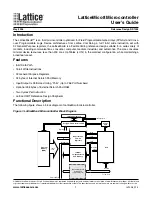
WARNING: Muting Limitations
Muting is allowed only during the non-hazardous portion of the machine cycle.
A muting application must be designed so that no single component failure can prevent the stop
command or allow subsequent machine cycles until the failure is corrected.
WARNING: Mute Inputs Must Be Redundant
It is not acceptable to use a single switch, device, or relay with two N.O. contacts for the mute inputs.
This single device, with multiple outputs, may fail so that the System is muted at an inappropriate time.
This could result in a hazardous situation.
Optional Muting Attributes
The Muting Sensor Pair Input and the Muting Block have several optional functions that can be used to minimize an
unauthorized manipulation and the possibility of an unintended mute cycle.
Mute Enable (ME)
The Mute Enable input is a non-safety-rated input. When the input is closed, or active for virtual input, the Safety Controller
allows a mute condition to occur; opening this input while the System is muted will have no effect.
Typical uses for Mute Enable include:
• Allowing the machine control logic to create a period of time for muting to begin
• Inhibiting muting from occurring
• Reducing the chance of unauthorized or unintended bypass or defeat of the safety system
The optional Mute Enable function may be configured to ensure that a mute function is permitted only at the appropriate
time. If a Mute Enable input device has been mapped to a Muting Block, the safety input device can be muted only if the
mute enable switch is in the enable (24 V dc) state, or active state for virtual input, at the time the mute cycle is started. A
mute enable input device can be mapped to one or more Muting Blocks.
Mute
Enable
ON or OFF
Safety
Input
Mute Sensor
Pair
Safety
Output
Figure 77. Timing logic—One mute sensor pair with mute enable
Simultaneity Timer Reset Function
The Mute Enable input can also be used to reset the simultaneity timer of the mute sensor inputs. If one input is active for
longer than 3 seconds before the second input becomes active, the simultaneity timer prevents a mute cycle from
occurring. This could be due to a normal stoppage of an assembly line that may result in blocking one mute device and the
simultaneity time running out.
If the ME input is cycled (closed-open-closed or active-inactive-active for virtual input) while one mute input is active, the
simultaneity timer is reset, and if the second mute input becomes active within 3 seconds, a normal mute cycle begins. The
function can reset the timer only once per mute cycle (all mute inputs M1–M4 must open before another reset can occur).
Bypass
An optional Bypass/Override Mode may be enabled by checking the BP (Bypass) box in the Muting Block properties
window. There are two available Bypass/Override Modes—Bypass and Mute Dependent Override. The Bypass mode is
used to temporarily bypass the safeguarding device to keep On or turn On the output of the function block. The Mute
Dependent Override mode is used to manually override an incomplete mute cycle (for example after the mute time limit
expires). In this case, one or more mute sensors must be activated while the safeguard is in the Stop state to initiate the
override.
XS/SC26-2 and SC10-2 Safety Controllers
www.bannerengineering.com - Tel: + 1 888 373 6767
93















































